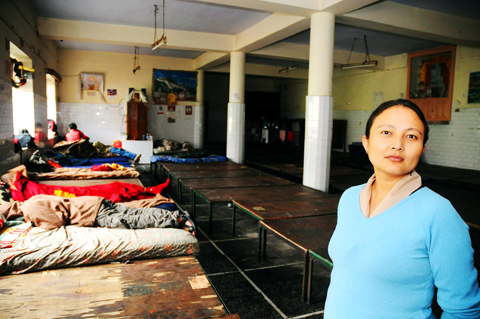|
ˇ@
Fewer Tibetans making escape to Dalai
Lama
AFP , DHARAMSALA, INDIA
Monday, Jul 26, 2010, Page 4
ˇ§We are deeply disappointed with the authorities in
Kathmandu ... Our disappointment stems from the realization that Nepal is so
vulnerable to Chinese pressure.ˇ¨ˇX Thubten Samphel, spokesman for the Tibetan
government-in-exile

Tibetan Reception Center for New Arrivals from
Tibet deputy director Mingyur Youdon poses in the centerˇ¦s near-empty
dormitories in Dharamsala, India, last Monday.
PHOTO: AFP
The Tibetan community in exile headed by the Dalai Lama is a constant irritant
for China, but Beijing has hit upon a way to weaken the movement: starve it of
new arrivals.
An almost empty dormitory in the gloomy main reception center for Tibetan exiles
in Dharamsala, the Indian hilltown home to the community, is a graphic
illustration of changes that have taken place over the last 18 months.
India has sheltered Tibetans since 1959, when the Dalai Lama fled his homeland
in fear for his life after a failed uprising against Chinese rule on the
strategic Tibetan plateau.
Since then, thousands of others have made the same treacherous trip to
Dharamsala, mostly via Nepal across snow-capped mountains on foot and horseback,
swelling the ranks of the population abroad to an estimated 200,000.
But today, fewer and fewer people are getting out.
ˇ§Up until March 2008, we used to have about 2,500 to 3,000 people arriving here
per year,ˇ¨ said Mingyur Youdon, the deputy director of the reception center in
McLeod Ganj, the uppermost part of Dharamsala. ˇ§Since February 2008, weˇ¦ve
received only about 1,000.ˇ¨
Her building is the sorting center for new arrivals where they are offered beds,
food, financial help, information on schooling if necessary, and, most
importantly for some, an audience with the Dalai Lama.
The drabness of the building is punctuated with pictures of the smiling
75-year-old spiritual leader, whose residence sits in an isolated spot just
outside the town with a panoramic view of the valley below.
A woman wailing with grief in the female dormitory is testament to the emotional
hardship of a life in exile.
THE CRACKDOWN
In March 2008, the date when arrivals in Dharamsala began falling, the capital
of Tibet was convulsed by a wave of violent protests against Chinese rule that
left an unknown number of people dead and injured.
China says 22 people died in the violence, which spread from Lhasa across Tibet
and neighboring regions with large populations of ethnic Tibetans.
The Tibetan government-in-exile says more than 200 died and 1,000 were hurt.
Following the violence, China tightened its already firm grip on the region by
sending reinforcements and clamping down on anyone suspected of dissent or
fomenting unrest.
Increased border controls are a consequence and Beijing has also leant heavily
on Nepal, the tiny republic wedged between Tibet and India, to arrest anyone
fleeing the region.
ˇ§We are deeply disappointed with the authorities in Kathmandu,ˇ¨ spokesman for
the Tibetan government in exile, Thubten Samphel, said from his office in one of
the many neat buildings used by the administration.
ˇ§Our disappointment stems from the realization that Nepal is so vulnerable to
Chinese pressure,ˇ¨ he said.
He says monitoring has increased on the Tibet-Nepal border, which is nowadays
the only way out for those wanting to flee, and claims that Chinese police
routinely enter Nepalese territory to pursue refugees.
ˇ§The most important reason for the restrictions is to prevent information going
out to the outside world regarding the oppression going on in Tibet,ˇ¨ he says.
COSTLY ESCAPES
In the male dormitory of the reception center, where only a quarter of the 70
beds are full, a group of monks and other recent escapees mill around, wary to
speak to a reporter for fear of reprisals back home.
Those willing to talk explain how the price has tripled to be guided over the
border: before March 2008, it cost about 5,000 yuan (US$737) to 6,000 yuan,
today the increased risk means smugglers demand 15,000 yuan and more.
One 15-year-old monk, who spoke passionately about his desire to return home one
day to help his compatriots, had paid 21,000 yuan. He arrived two weeks ago and
said his trip entailed seven days of walking in the dead of night.
ˇ§They have put extra forces in Tibet. Everytime we go outside, the Chinese
police are always watching us, especially the monks,ˇ¨ he said.
ˇ§At present, the situation inside Tibet is very tense. I escaped to India to get
a traditional religious education,ˇ¨ the monk said.
On the other side of McLeod Ganj in a steep valley sits the sprawling Tibetan
school, where around 2,000 children of all ages study on a campus where
basketball is taught alongside traditional Tibetan opera.
FEWER PUPILS
Despite the evidence of US sports here, the curriculum is designed to instill a
sense of nationhood in young Tibetans with emphasis placed on their long
cultural history and unique language.
The views are breathtaking, with high snow-capped Himalayan peaks behind and
miles of rolling hills in front that eventually give way to the vast sun-baked
Indian Gangetic plain.
ˇ§The number joining us from Tibet has decreased noticeably,ˇ¨ school director
Phuntsok Namgyal said. ˇ§We used to get 700-800 children every year on average
and since 2008 the number has reduced considerably.ˇ¨
ˇ§Itˇ¦s very obvious that fewer children can make their way to India,ˇ¨ he said.
He estimates only 250 children have enrolled in the school in the last 18
months, an ominous sign for a movement determined to protect Tibetan culture and
fight for Tibetan independence or autonomy under Chinese rule.
The pioneers who came in 1959 are well past retirement age and, like the Dalai
Lama, will one day be gone.
ˇ§Itˇ¦s a serious concern for all of us,ˇ¨ Namgyal said.
ˇ@
|
![]()
![]()
![]()